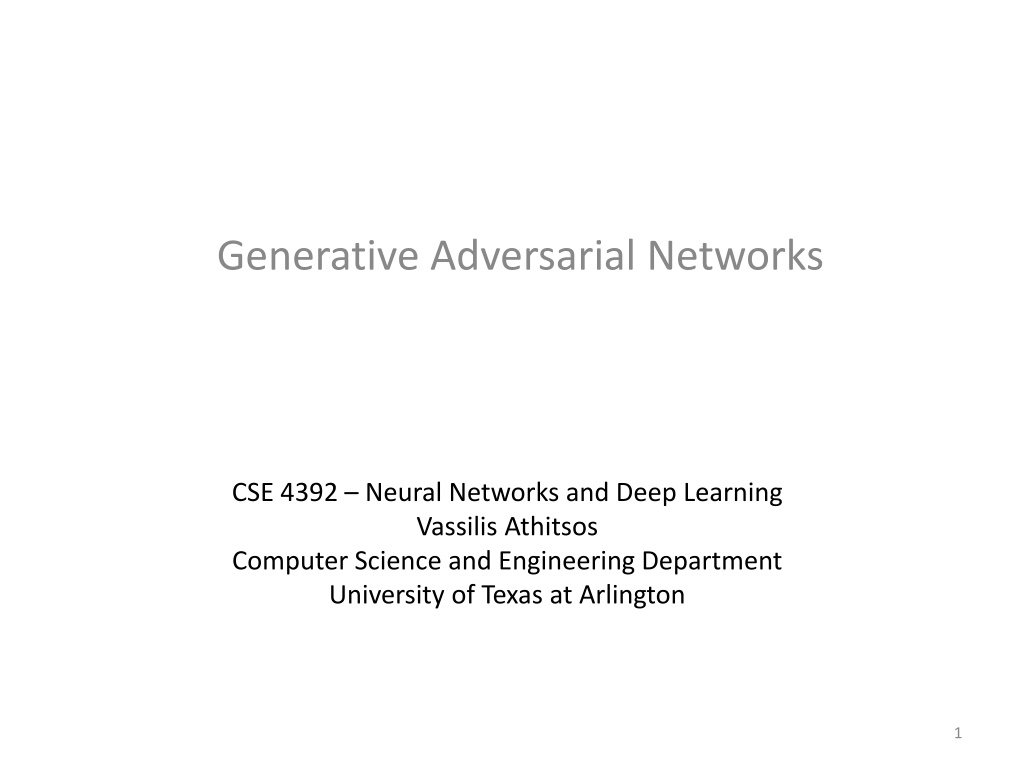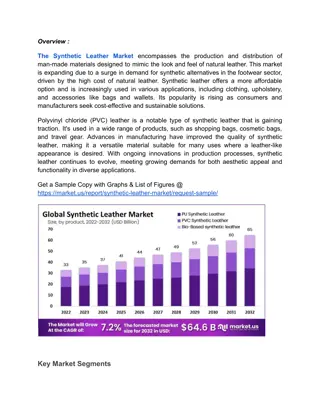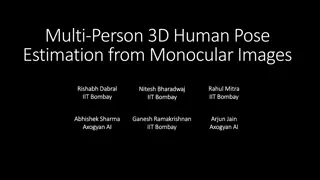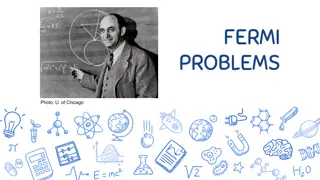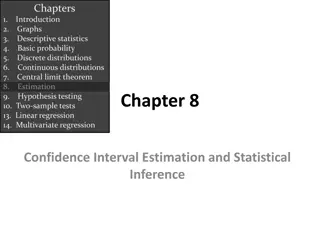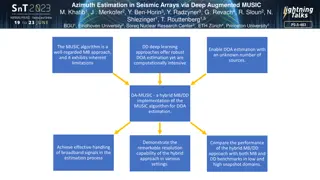Understanding Synthetic Data and Hand Pose Estimation
Synthetic data, generated by machines, is utilized in various applications such as hand pose estimation in neural networks. Handshapes and their 3D orientation play a crucial role in accurate estimations, with applications ranging from sign language recognition to clinical studies. Labeled datasets are essential for training models effectively in this domain.
Download Presentation

Please find below an Image/Link to download the presentation.
The content on the website is provided AS IS for your information and personal use only. It may not be sold, licensed, or shared on other websites without obtaining consent from the author. Download presentation by click this link. If you encounter any issues during the download, it is possible that the publisher has removed the file from their server.
E N D
Presentation Transcript
Generative Adversarial Networks CSE 4392 Neural Networks and Deep Learning Vassilis Athitsos Computer Science and Engineering Department University of Texas at Arlington 1
Synthetic Data Synthetic data is data that is generated by a machine. For example: A real face image is a photograph of someone s face. A synthetic face is an image made up by a computer program, that may have been designed to resemble someone, or may have been designed to not resemble anyone. Synthetic data can have many forms: Synthetic text, for example a story or script or joke (or attempted joke) produced by a computer program. Synthetic music. Synthetic images and video. 2
Uses of Synthetic Data What are possible uses of synthetic data? Synthetic data is often used as training data, especially when real data is not as abundant as we would like. One example is hand pose estimation. input image Hand pose: Hand shape 3D hand orientation. 3
Hand Shapes Handshapes are specified by the joint angles of the fingers. Hands are very flexible. Each finger has three joints, whose angles can vary. 4
3D Hand Orientation Images of the same handshape can look VERY different. Appearance depends on the 3D orientation of the hand with respect to the camera. Here are some examples of the same shape seen under different orientations. 5
Hand Pose Estimation: Applications There are several applications of hand pose estimation (if the estimates are sufficiently accurate, which is a big if): Sign language recognition. Human-computer interfaces (controlling applications and games via gestures). Clinical applications (studying the motion skills of children, patients ). input image Hand pose: Hand shape 3D hand orientation. 6
Labeling Data for Hand Pose In order to apply the methods we have learned this semester for hand pose estimation, we need a labeled training set. The term labeled simply means that for every training input we know the target output. Every single dataset we have used this semester was labeled. Usually the labels (target outputs) were given as part of the dataset. Sometimes you had to write code that generated the labels automatically (for example, by reversing the word order in a sentence and then labeling that sentence as reverse). Instead of the term labels you will often see terms like ground truth or annotations . 7
Labeling Data for Hand Pose Labeling the hand pose in an image is relatively time- consuming and error-prone. To better understand the difficulty, consider labeling an MNIST image, which is relatively fast and reliable. If a human looks at an MNIST image, most of the times the human knows immediately what the correct label is, and can provide that label by pressing a key. On the other hand, if we look at a hand image, we may understand intuitively what the pose is, but our brain cannot convert this intuitive understanding to actual joint angles. Alternatively, instead of labeling joint angles, we can label the pixel positions of the 15 joints. That is an easier task, but still rather time-consuming.b 8
Synthetic Hand Images The images shown here were computer-generated. Given joint angles, the program produces an image. We can write a script that generates millions of joint angle combinations and the corresponding images.
Synthetic Hand Images For synthetic hand images, we get the labels for free. The joint angles shown in the images are produced by our own code. This means that we can generate a large training dataset easily.
Training on Synthetic Hand Images Problem: synthetic images are not quite the same as real images. A model can learn to predict hand pose very accurately in synthetic images, and still be very inaccurate in real images. Therefore, we want synthetic images that are as realistic as possible.
Anonymizing Images and Video Another application of synthetic data is in anonymizing images and video. For people using English (or any other language that people know how to read and write), it is straightforward to write anonymous text expressing their thoughts and opinions. For American Sign Language, there is no commonly used way to write it as text. The typical way for a sign language user to state their thoughts or opinions is for the user to record a video. However, the video shows the user, so the user desires to be anonymous, video is a far worse option than text. Potential solution: convert the video so that it shows a made- up (but realistic-looking) person doing the signing. 12
Realistic Scenes in Games and Movies Realistic synthetic data is highly valued in the gaming and entertainment industry. For example: Scenes in sci-fi and phantasy movies may integrate real actors and landscapes with imaginary creatures and landscapes. Scenes in action movies showing explosions and massive destruction can be much safer and cheaper to produce if they are not real. In computer games, it may be important for people, objects and/or scenery to look realistic. Realistic motion is also important, and can be very challenging to synthesize (for example, realistic motion of smoke, fire, water, humans and animals). 13
Generative Adversarial Networks Generative Adversarial Networks (GANs) were introduced in 2014 by this paper: Goodfellow, Ian; Pouget-Abadie, Jean; Mirza, Mehdi; Xu, Bing; Warde-Farley, David; Ozair, Sherjil; Courville, Aaron; Bengio, Yoshua (2014). Generative Adversarial Nets (PDF). Proceedings of the International Conference on Neural Information Processing Systems (NIPS 2014). pp. 2672 2680. https://arxiv.org/abs/1406.2661 GANs have become very popular and are commonly used to generate realistic synthetic data. 14
Generator and Discriminator What we really want is a generator : a module that produces realistic synthetic data. However, in a GAN model, we essentially train two separate modules that compete with each other: The generator module, that produces synthetic data that is hopefully very realistic. A discriminator module, that is trained to recognize if a piece of data is real or synthetic. 15
Generator and Discriminator The word adversarial in Generative Adversarial Networks refers to the fact that the generator and the discriminator actually compete with each other. The goal of the generator is to be so good that it can fool the discriminator as often as possible. A good generator produces synthetic data that cannot be distinguished from real data, so the discriminator fails at that task. The goal of the discriminator is to be so good that it cannot be fooled by the generator. The discriminator should tell with high accuracy if a piece of data is real or synthetic. 16
How It (Hopefully) Works The first version of the generator is initialized with random weights. Consequently, it produces random images that are not realistic at all. The discriminator is trained on a training set that combines: A hopefully large number of real images. An equally large number of images produced by the generator. Since the generated images are not realistic, the discriminator should achieve very high accuracy on this initial training set. Now we can train a second version of the generator. Each input is just a random vector, that is used to make sure that the output images are not identical to each other. The loss function is computed by giving the output of the generator to the discriminator. The more confident the discriminator is that the image is synthetic, the higher the loss. 17
How It (Hopefully) Works The second version of the generator should be better than the initial version with random weights. The output images should now be more realistic. We now train a second version of the discriminator, incorporating into the training set the output images of the second version of the generator. Then, we train a third version of the generator, using the second version of the discriminator. And so on, we keep training alternatively: a new version of the discriminator, using the latest version of the discriminator. a new version of the generator, using the latest version of the discriminator. 18
Problems With Convergence In the models we have trained previously this semester, we were optimizing a single loss function. Both theoretically and practically, we knew that we would get the model weights to converge to a local optimum. Here, we have two competing loss functions: The generator loss function, that is optimized as the generator gets better at fooling the discriminator. The discriminator loss function, that is optimized as the discriminator gets better at NOT being fooled by the generator. We optimizing these losses iteratively, one after the other. It would be nice to be able to guarantee that after each iteration, both the generator and the discriminator are better (or at least not worse) than they were before that iteration. Unfortunately, the opposite can also happen. 19
Problems With Convergence For example, suppose that we get to a point where the generator is really great, and it fools the discriminator to the maximum extent. What is the maximum extent ? The discriminator has to solve a binary classification problem: real vs. synthetic . A random classifier would attain 50% accuracy. With a perfect generator, the discriminator will be no better and no worse than a random classifier. If the generator is perfect, training the discriminator will produce a useless model, equivalent to a random classifier. The previous version of the discriminator, trained with data from an imperfect generator, would probably be better than the current version. 20
Problems With Convergence Conversely, suppose that we get to a point where the discriminator is 100% accurate, so that it is never fooled. In that case, training the generator will produce a useless model, equivalent to a random image generator, since there will be no effect in the loss function by producing more realistic images. The previous version of the generator, trained with data from an imperfect discriminator, would probably be better than the current version. So, overall, if one of the two components gets too good, then that makes it harder to improve the other component. In practice, GANs are used and often produce great results, but the system designer may need to manually intervene to guide the training to the right direction. Overall, training GANs is somewhat complicated and heuristic. 21
